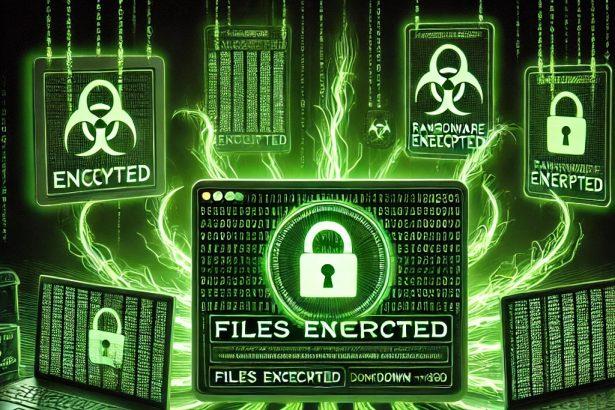Tiger4444—also known simply as Tiger Ransomware or part of the GlobeImposter family—emerged in early August 2025. It targets Windows systems, encrypting user files and appending the .Tiger4444 extension, then demanding payment for decryption.
Overview of the Threat
| Field | Details |
|---|---|
| Threat type | Ransomware / Crypto‑virus |
| Encrypted file extension | .Tiger4444 (e.g. myphoto.jpg.Tiger4444) |
| Ransom note file name | HOW TO BACK YOUR FILES.txt |
| Associated email addresses | China.helper@aol.com, China.helper@india.com |
| Detection names | Avast: Win32:Malware‑gen; Combo Cleaner: GenPack:Trojan.Ransom.Maoloa.A; ESET‑NOD32: A Variant Of Win32/Filecoder.Maoloa.C; Kaspersky: Trojan‑Ransom.Win32.Encoder.aeiz; Microsoft: Ransom:Win32/Maoloa.KA |
| Symptoms | Files inaccessible with .Tiger4444 suffix; ransom note displayed; system unable to open affected files |
| Distribution methods | Spam email attachments (macros), torrent sites, malicious ads, malicious downloads, fake cracks |
| Damage | All targeted files encrypted; potential additional malware installed with ransomware |
| Danger level | High – irreversible file encryption, data loss, further malware risk |
| Removal tool | SpyHunter (recommended removal tool) (Download SpyHunter) |
Ransom Note Text
The ransom note HOW TO BACK YOUR FILES.txt reads:
YOUR FILES ARE ENCRYPTED !!!
TO DECRYPT, FOLLOW THE INSTRUCTIONS:
To recover data you need decrypt tool.
To get the decrypt tool you should:
- In the letter include your personal ID! Send me this ID in your first email to me!
- We can give you free test for decrypt few files (NOT VALUE) and assign the price for decryption all files!
- After we send you instruction how to pay for decrypt tool and after payment you will receive a decryption tool!
- We can decrypt few files in quality the evidence that we have the decoder.
DO NOT TRY TO DO SOMETHING WITH YOUR FILES BY YOURSELF YOU WILL BRAKE YOUR DATA !!! ONLY WE ARE CAN HELP YOU! CONTACT US:
China.helper@aol.com
China.helper@india.com
ATTENTION !!! THIS IS YOUR PERSONAL ID WICH YOU HAVE TO SEND IN FIRST LETTER:
Detailed Threat Evaluation
How did I get infected?
Infections typically occur through phishing emails containing malicious attachments (often with macros), drive‑by downloads disguised as legitimate software, torrent downloads or cracked application packages, and malicious ads or links that deliver a trojan downloader. Once opened or executed, the ransomware encrypts files and installs additional payloads.
What does it do?
Upon execution, Tiger4444 encrypts files using strong cryptographic algorithms and appends .Tiger4444 to filenames. It then drops a ransom note (HOW TO BACK YOUR FILES.txt) demanding a paid decrypt tool. The malware disables access to files and warns against manual or third‑party decryption, threatening permanent data loss otherwise.
Should you be worried for your system?
Yes—this ransomware poses a serious risk. Once files are encrypted, only backups can restore data. Paying ransom is discouraged: attackers may not deliver a working decryption tool and paying encourages further criminal behavior. Additionally, many ransomware infections bundle other malware such as trojans or credential‑stealers, compounding the damage.
Manual Ransomware Removal Process
Important: Manual removal is recommended only for experienced users, as incorrect actions can lead to data loss or incomplete removal of the ransomware. If unsure, consider the SpyHunter Removal Method for a guided, automated solution.
Step 1: Disconnect from the Internet
- Immediately disable Wi-Fi or unplug the Ethernet cable to prevent the ransomware from communicating with remote servers.
- This can prevent additional encryption or further infections.
Step 2: Boot into Safe Mode
For Windows Users
- Windows 10/11:
- Press Windows + R, type
msconfig, and press Enter. - Under the Boot tab, select Safe boot and check Network.
- Click Apply, then OK, and restart your PC.
- Press Windows + R, type
- Windows 7/8:
- Restart your PC and press F8 repeatedly before Windows starts.
- Select Safe Mode with Networking and press Enter.
For Mac Users
- Restart your Mac and hold the Shift key immediately after the startup chime.
- Release the key when the Apple logo appears.
- Your Mac will boot in Safe Mode.
Step 3: Identify and Terminate Malicious Processes
Windows
- Open Task Manager by pressing Ctrl + Shift + Esc.
- Look for unusual processes consuming high CPU or memory.
- Right-click on the suspicious process and select End Task.
Mac
- Open Activity Monitor (Finder > Applications > Utilities > Activity Monitor).
- Look for unknown or high-resource-consuming processes.
- Select the suspicious process and click Force Quit.
Step 4: Delete Ransomware Files
Windows
- Open File Explorer and navigate to:
C:\Users\[Your Username]\AppData\LocalC:\Users\[Your Username]\AppData\RoamingC:\Windows\System32
- Identify and delete suspicious files (randomly named or recently modified items).
- Clear temporary files:
- Press Windows + R, type
%temp%, and hit Enter. - Delete all files in the Temp folder.
- Press Windows + R, type
Mac
- Open Finder and select Go > Go to Folder.
- Type
~/Library/Application Supportand check for unfamiliar files or folders. - Remove unknown
.plistfiles from~/Library/LaunchAgents.
Step 5: Remove Ransomware Entries from Registry or System Settings
Windows
- Press Windows + R, type
regedit, and hit Enter. - Navigate to:
HKEY_CURRENT_USER\SoftwareHKEY_LOCAL_MACHINE\Software
- Identify and delete ransomware-related registry entries.
Mac
- Open System Preferences > Users & Groups.
- Select the Login Items tab and remove any unknown startup programs.
- Check
~/Library/Preferencesfor malicious settings.
Step 6: Restore System Using a Backup or Restore Point
Windows
- Press Windows + R, type
rstrui, and press Enter. - Choose a restore point from before the infection and proceed.
Mac
- Restart your Mac and enter macOS Utilities by holding Command + R.
- Select Restore from Time Machine Backup and restore a safe backup.
Step 7: Attempt to Decrypt Files
- Check No More Ransom (www.nomoreransom.org) for available decryption tools.
- If unavailable, restore files from backups.
Automated Ransomware Removal with SpyHunter
If manual removal is too complex or risky, SpyHunter offers a safer, automated method for detecting and removing ransomware.
Step 1: Download SpyHunter
- Get SpyHunter from the official Enigma Software website.
Step 2: Install SpyHunter
- Open the downloaded file (
SpyHunter-Installer.exeor.dmgfor Mac users). - Follow the installation prompts.
- Launch SpyHunter upon completion.
Step 3: Run a Full System Scan
- Click Start Scan Now to detect malware and ransomware.
- Wait for the scan to complete and review detected threats.
Step 4: Remove Detected Ransomware
- Click Fix Threats to remove identified ransomware components.
- SpyHunter will clean your system automatically.
Step 5: SpyHunter’s Custom Malware HelpDesk
- If ransomware persists, use SpyHunter’s Malware HelpDesk for custom malware fixes.
Step 6: Restore Files
- Use backups stored on external drives or cloud storage.
- If no backup is available, check No More Ransom for decryption tools.
Preventing Future Ransomware Attacks
- Keep backups: Use cloud storage or an external hard drive.
- Install a reliable security tool: SpyHunter offers real-time protection against malware.
- Enable Windows Defender or Mac security features for additional protection.
- Avoid phishing emails and unknown attachments.
- Regularly update Windows, macOS, and installed applications.
Conclusion
Tiger4444 / Tiger Ransomware is a high‑risk crypto‑locker threat that encrypts files, demands payment, and may install additional malware. Removal does not restore encrypted files—recovery is only possible via backups. Paying ransom is risky and may yield no results. Instead, scan immediately with a legitimate tool like SpyHunter, isolate the infected system, and rely on backups for data recovery.




